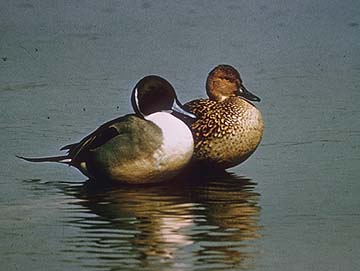
The Northern pintail, commonly referred to as pintail, has a body-length of 20-29 inches and averages 1.9-2.3-pounds. Drakes are also called “sprigs.” Pintail are among the most beautifully marked of all the ducks.
A pintail male in breeding plumage has a brown head, white neck and breast, and a gray back and sides. Females are grayish brown and are typically the most mis-identified duck of all the ducks harvested in the central flyway of the United States. Typically, novice birders and hunters think pintail hens are gadwall. The speculum is metallic greenish-brown with a white rear border. But far more noticeable in flight is the male’s long, slender, pointed tail. Pintails are extremely graceful and fast fliers, fond of zig-zagging from great heights before leveling off to land. Voice: the drake has a flute-like whistle, the hen a soft quack.
In summer and fall, pintails feed largely on seeds and vegetative parts of pondweeds and other submergent vegetation and on the seeds of bulrushes and smartweeds. Nesting females eat more aquatic insects. Sometimes pintails land in harvested fields to glean waste corn. They breed mainly across Canada, the northwestern United States and in Alaska.
Pintails often nest in dead herbaceous cover of the past year’s growth, which may offer little concealment. They will also nest in fallow fields and even in crop stubble! The nest site is usually within 100-yards of water, but may be up to a mile away. Females lay around 9 eggs that hatch following an incubation period of 21 days. Pintails in the central flyway winter the Texas panhandle and on the coast along the Gulf of Mexico.


Pintail are good looking ducks. We love watching them in the off season as well as when they decoy during the hunting season.